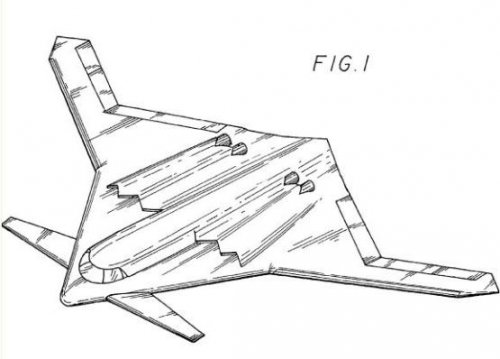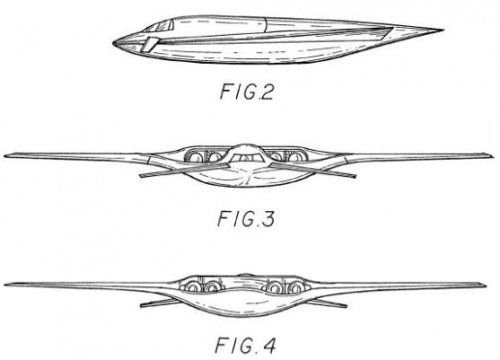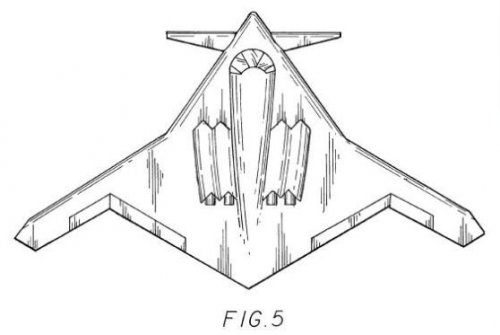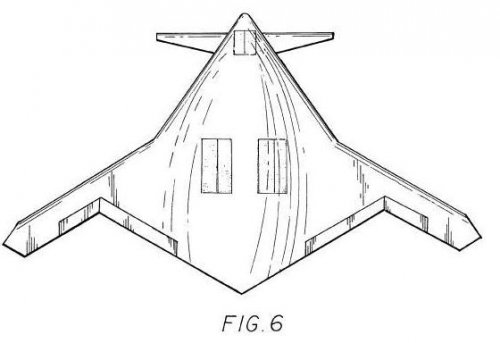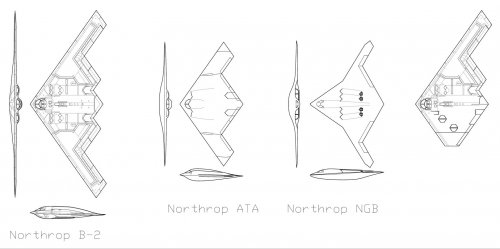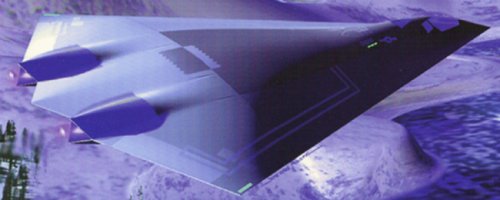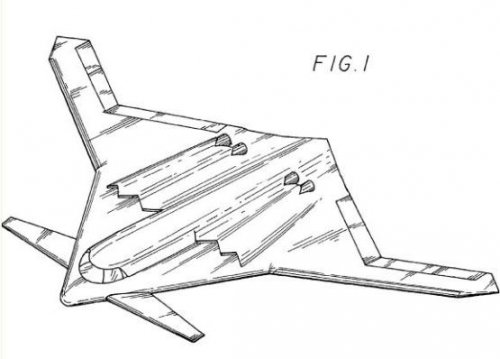You are using an out of date browser. It may not display this or other websites correctly.
You should upgrade or use an alternative browser.
You should upgrade or use an alternative browser.
US Next Generation Bomber Studies
- Thread starter flateric
- Start date
flateric said:I was always wondering if there's a special persons in aerospace industry who takes original drawings/CAD printouts and degrades them to a harsh level we see in patents like this? =)
Actually, sorta, yeah. A few of my CAD drawings have made it into patents*; and while they are recognizably the same items, they have all been rendered in this same "19th century" drawing style.
A decade ago, when I first started digging through patents, I thought that requiring that all drawings be rendered in this fashion was an odd anachronism. But with a little thought, two conclusions came:
1) The style does a very good job of showing what it needs to show
2) If drawing styles were allowed to vary, in the 1960's/70's there'd be patents that look like crap from Peter Max.
*6612522, 6629673, 6726154, 6119985, D405750, I think one or two others
- Joined
- 17 October 2006
- Messages
- 2,282
- Reaction score
- 607
I suspect a patent drawing is also intended to show what it needs to show to protect the invention, without at the same time giving the game away. And it's also covered by legal convention.
antigravite
ACCESS: Top Secret
- Joined
- 25 April 2008
- Messages
- 833
- Reaction score
- 225
LowObservable said:I suspect a patent drawing is also intended to show what it needs to show to protect the invention, without at the same time giving the game away. And it's also covered by legal convention.
Yes indeed. Years ago, I already had to draw (in a 24h rush, and for the fashion industry) a similar decorative art patent together with a Client and an Intellectual Property Attorney. The rush had something to do with a trade show. To my bewilderment, the drawing specs were extremely constraining. Essentially, we said everything un a very subtle way (proportions, things which had to be hidden, folded, etc.). We did not want nor had to give away the exact shapes because this is not the key issue. The final design would change (wether in the aerospace or fashion industries). We did notcare about hidding things : we only needed to protect similarly looking VARIANTS. And that's the key issue with this planform. I find this design patent far more detailed than one could have expected.
- Joined
- 1 April 2006
- Messages
- 10,729
- Reaction score
- 6,754
ho-ho-ho, Flight International's John Croft strikes back
http://www.flightglobal.com/blogs/as-the-croft-flies/2009/03/b-2-meets-brothers-wright.html
http://www.flightglobal.com/blogs/as-the-croft-flies/2009/03/b-2-meets-brothers-wright.html
Attachments
- Joined
- 17 October 2006
- Messages
- 2,282
- Reaction score
- 607
//shakes tiny fist at Croft
- Joined
- 1 April 2006
- Messages
- 10,729
- Reaction score
- 6,754
what NG needs those mustaches for? they are not kosher in terms of RCS, and I'd be happy to sea to technical solution to retract 'em into the leading edge...can't believe that FBW can't handle stability problems at take-off and landing
- Joined
- 17 October 2006
- Messages
- 2,282
- Reaction score
- 607
Rutan attacks!
http://www.aviationweek.com/aw/blogs/defense/index.jsp?plckController=Blog&plckScript=blogScript&plckElementId=blogDest&plckBlogPage=BlogViewPost&plckPostId=Blog%3a27ec4a53-dcc8-42d0-bd3a-01329aef79a7Post%3a390ca009-e27c-455c-8042-d92ea180b071
http://www.aviationweek.com/aw/blogs/defense/index.jsp?plckController=Blog&plckScript=blogScript&plckElementId=blogDest&plckBlogPage=BlogViewPost&plckPostId=Blog%3a27ec4a53-dcc8-42d0-bd3a-01329aef79a7Post%3a390ca009-e27c-455c-8042-d92ea180b071
- Joined
- 1 April 2006
- Messages
- 10,729
- Reaction score
- 6,754
Orionblamblam said:NOTE: the SOF VTOL variant at far right is a work in progress.
Educated guess or based on something else?
- Joined
- 18 March 2008
- Messages
- 3,532
- Reaction score
- 724
flateric said:what NG needs those mustaches for? they are not kosher in terms of RCS, and I'd be happy to sea to technical solution to retract 'em into the leading edge...can't believe that FBW can't handle stability problems at take-off and landing
As Bill Sweetman points out extra take off weight. And what do you do with flight appendages only needed for takeoff? You don't retract them (especially with that anhedral), you drop them from the aircraft.
- Joined
- 1 April 2006
- Messages
- 10,729
- Reaction score
- 6,754
anhedral doesn't mean much (look at Tu-144 canards)
you can move them underneath of the forward fuselage, or they may represent a part of leading edge
technically problem is solvable, but no one says it would be piece of cake
you can move them underneath of the forward fuselage, or they may represent a part of leading edge
technically problem is solvable, but no one says it would be piece of cake
- Joined
- 17 October 2006
- Messages
- 2,282
- Reaction score
- 607
Yes, your host nation loves having canards dropped on their heads. Retraction is complicated but presumably someone thinks that the design still converges at a better place.
flateric said:Orionblamblam said:NOTE: the SOF VTOL variant at far right is a work in progress.
Educated guess or based on something else?
Based on artwork that has appeared in a few places. The lift fans, while more or less matching the art, seem pretty small.
- Joined
- 26 May 2006
- Messages
- 32,688
- Reaction score
- 11,914
Hi,flateric said:Shown in paper dedicated to High-Frequency Excitation Active Flow Control High-Speed Weapon Release (HIFEX) study - an active flow control approach for high-speed weapon dispense from a weapons bay, this rendering may represent Boeing's approach for Mach 2-4 LRSA from 2004.
http://cndyorks.gn.apc.org/yspace/articles/long-range-strike_02.jpg
Attachments
- Joined
- 18 March 2008
- Messages
- 3,532
- Reaction score
- 724
LowObservable said:Yes, your host nation loves having canards dropped on their heads.
Its a non issue. Any dropping of surplus flight appendages would be conducted over special areas and there might even be a recover and reuse capability.
LowObservable said:Retraction is complicated but presumably someone thinks that the design still converges at a better place.
Its a lot of extra weight (retraction gear) for what is supposed to help take off weight... Also the volume consumed is where the radar's go.
But don't let that get in the way of a pet theory...
Spring
ACCESS: Confidential
- Joined
- 4 June 2008
- Messages
- 92
- Reaction score
- 0
Abraham Gubler said:LowObservable said:Yes, your host nation loves having canards dropped on their heads.
Its a non issue. Any dropping of surplus flight appendages would be conducted over special areas and there might even be a recover and reuse capability.
Probably you also will need them for landing
Is interesting , but not surprising really, the new design chosen, is basically the Lockheed's B-2 idea, which is the idea for the Northrop UAVs, Lockheed solved the obvious issue of lack of nose lifting force with a tail, northrop is "solving" this issue with a canard, which, for the "puritans" -read missinformed- is not "stealthy"....but it really does not affect the RCS, unless is not aligned or has not a slopped shape, which of course is not the case of the concept here..
- Joined
- 4 May 2008
- Messages
- 2,440
- Reaction score
- 675
Abraham Gubler said:Its a non issue. Any dropping of surplus flight appendages would be conducted over special areas and there might even be a recover and reuse capability.
I guess if you're flying over Nevada or Utah, or the Australian outback, you have a chance of finding such an area. In Europe you couldn't drop a pin from altitude without hitting someone on the ground. Over water you'd have 50% chance of recovering the thing. Discarding aerodynamic surfaces can sometimes look like an attractive option at the conceptual design phase. But the CONOPS guy in the design group would commit suicide over such a thing.
As a side note, I can only think of the Hurricane discardable wing for ferrying purposes as an example of such device.
AeroFranz said:As a side note, I can only think of the Hurricane discardable wing for ferrying purposes as an example of such device.
Drop tanks.
Matej
Multiuniversal creator
I saw in the Europe the Mi-24 that after the attempt of the veeery fast flight lost its whole cannon and surprisingly - they later found it 
Okay, but now on the serious note - yes, we already have the drop tanks, but how often are they being dropped? In some situations it is usefull solution, but in fact in any situation it is COSTLY solution. It does not matter that it is generally only the piece of metal. When you have the expendable parts of the airplane (or any other flying device), you can have a bit better characteristics, but the price is usually big. The extreme were the additional expendable engines proposed on some high-speed Convair designs sometime in the era of Fish and Kingfish.
Not to mention that there is still a risk that the expendable canard can after extraction damage the leading edge and/or the fuselage of the aircraft.
Okay, but now on the serious note - yes, we already have the drop tanks, but how often are they being dropped? In some situations it is usefull solution, but in fact in any situation it is COSTLY solution. It does not matter that it is generally only the piece of metal. When you have the expendable parts of the airplane (or any other flying device), you can have a bit better characteristics, but the price is usually big. The extreme were the additional expendable engines proposed on some high-speed Convair designs sometime in the era of Fish and Kingfish.
Not to mention that there is still a risk that the expendable canard can after extraction damage the leading edge and/or the fuselage of the aircraft.
- Joined
- 4 May 2008
- Messages
- 2,440
- Reaction score
- 675
Orionblamblam said:Drop tanks.
I should have specified flying surface as opposed to a generic device
And yeah, as Matej pointed out no one will drop tanks in peacetime. The aforementioned "slip wing" on the Hurricane apparently separated ok, but it was mounted with a good vertical separation with respect to the fuselage. in this case there would be none.
- Joined
- 18 March 2008
- Messages
- 3,532
- Reaction score
- 724
Spring said:Probably you also will need them for landing.
For a high fuel fraction aircraft like a bomber the aircraft is in a completely different state for landing. As Sweetman points out in the original post on ARES about this need it is to help boost nose lift at takeoff because of high weight. With that weight overboard it would not be needed at a normal landing.
AeroFranz said:I guess if you're flying over Nevada or Utah, or the Australian outback, you have a chance of finding such an area. In Europe you couldn't drop a pin from altitude without hitting someone on the ground. Over water you'd have 50% chance of recovering the thing. Discarding aerodynamic surfaces can sometimes look like an attractive option at the conceptual design phase. But the CONOPS guy in the design group would commit suicide over such a thing.
Since the canards are only needed for takeoff it is a very different situation to drop tanks or other expendables. Also since it is for a long range bomber taking off in a rare high weight situation it is not a normal or oft used method. The US doesn’t base B-2s in congested inner European airfields nor will they base the NGLRS aircraft there. Guam, Diego Garcia, etc are the bases of choice. Since the canard is dropped as part of the takeoff profile it is nothing like dropping an empty fuel tank half way through a mission.
AeroFranz said:As a side note, I can only think of the Hurricane discardable wing for ferrying purposes as an example of such device.
Lots of bomber and recce designs during the 50s and 60s used such discardable wing surfaces.
This is simple Ocam's razor stuff. For a hand full of very high weight takeoffs do you A. design a complex 3 dimensional travel, retractable canard that consumes lots of internal space (where you need to locate your radars) and considerable additional weight that is only used on a small percentage of takeoffs. Or do you add a jettisonable, disposable canard?
- Joined
- 4 May 2008
- Messages
- 2,440
- Reaction score
- 675
Lots of bomber and recce designs during the 50s and 60s used such discardable wing surfaces
I'm drawing blank...can you enlighten me?
AeroFranz said:Lots of bomber and recce designs during the 50s and 60s used such discardable wing surfaces
I'm drawing blank...can you enlighten me?
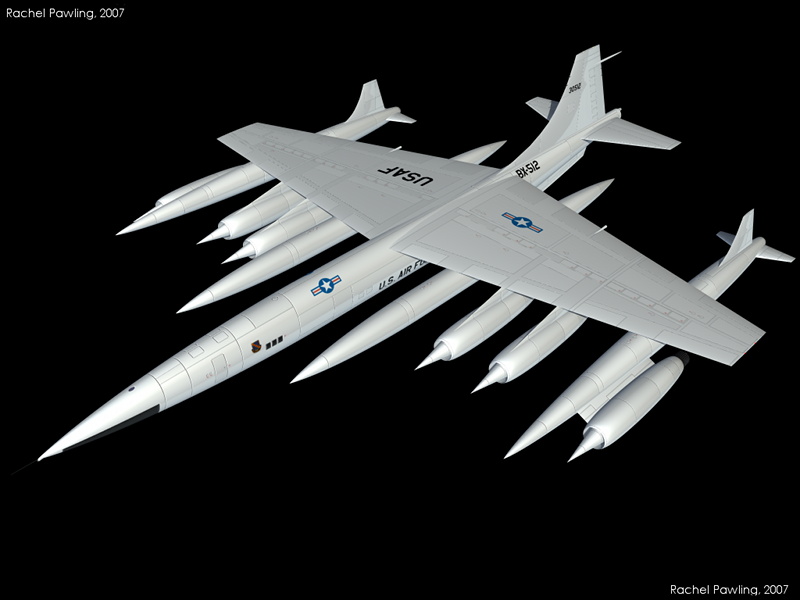
- Joined
- 4 May 2008
- Messages
- 2,440
- Reaction score
- 675
Oh, ok, Thanks for the examples, Scott. I was trying to think of operational aircraft.
I can see how an advanced concept group might come up with these solutions, especially in the face of stringent requirements (or if your mission is once-in-a-lifetime delivery of thermonuclear warheads at high speeds over long distances). My two cents is that it's far from practical, which I suspect is why we've never seen an operational example, just conceptual designs.
I can see how an advanced concept group might come up with these solutions, especially in the face of stringent requirements (or if your mission is once-in-a-lifetime delivery of thermonuclear warheads at high speeds over long distances). My two cents is that it's far from practical, which I suspect is why we've never seen an operational example, just conceptual designs.
- Joined
- 18 March 2008
- Messages
- 3,532
- Reaction score
- 724
AeroFranz said:I can see how an advanced concept group might come up with these solutions, especially in the face of stringent requirements (or if your mission is once-in-a-lifetime delivery of thermonuclear warheads at high speeds over long distances).
Bear in mind that the important factor is "flying wing". The various aircraft designs that used expendable flying surfaces did so to carry more fuel into the air and rid themselves of the aerostructure weight needed for this fuel after they had consumed it. But all of these aircraft were of conventional wing-fuselage design.
The Northrop Grumman design in question is a flying wing and has different aerodynamic and design factors. In particular the difference is the relationship between the wing (ie centre of lift) and centre of gravity. On any conventional aircraft the wing will always be positioned to match lift with the weight balances. But for the flying wing weight needs to be positioned to match the centre of lift. Which means with high wing sweep angles that the nose needs to be unloaded.
There have been very few flying wing designs compared to conventional fuselage designs so the exploration of aerodynamic options is no where near the same level for flying wings and blended wing bodies.
AeroFranz said:The aforementioned "slip wing" on the Hurricane apparently separated ok, but it was mounted with a good vertical separation with respect to the fuselage. in this case there would be none.
I'm taking no position on the "retract vs drop" arguement. But I will point out that the drawing show the canards having substantial anhedral. The reason why I think that might be relevant: if they are meant as droppable items, and *I* was tasked with designing them to do just that, I'd give them anhedral. And a two-stage ejection system:
1) Mechanical thrusters of considerable force and the better part of a foot's stroke to separate them from the aircraft
2) Solid rocket boosters to send them on their way (likely a single rocket booster using a non-aluminized min smoke propellant and with dual nozzles, one below, one above, so that the exhaust plume does not impact the plane)
With anhedral, the canards would rocket away and fall safely beneath the wing. If they had no dihedral, they'd be in the way of the main wing.
This'd be a fairly straightforward design job. I did a bit of work on systems like this for upper stage sep systems for launch vehicles; same basic issues and mechanisms would be involved. Put a small parachute pack on 'em and fill them full of foam and give them a beacon, and a tugboat full of bored sailors could go and fish them out of the water off the ends of the Guamanian and Diego Garcia runways. Heck, the chute might not even be needed... just let 'em lawn dart into the sea, and bob back up to the surface.
Spring
ACCESS: Confidential
- Joined
- 4 June 2008
- Messages
- 92
- Reaction score
- 0
I'm not really that sure if that is the ideal placement for an attached/dropping device, Abraham Gubler
I think at the end they will need these canards for landing with heavy loads, one thing is truth, the max. landing weight figure is in general lower than the max. take off figure, so you might be right, but then is probably that both figures are higher than the baseline design
-I think it was already pointed out-
I think at the end they will need these canards for landing with heavy loads, one thing is truth, the max. landing weight figure is in general lower than the max. take off figure, so you might be right, but then is probably that both figures are higher than the baseline design
-I think it was already pointed out-
- Joined
- 17 October 2006
- Messages
- 2,282
- Reaction score
- 607
Interesting hypothesis, Sir.
Now, would there be a way of making the canards themselves "dumb" - that is, with no actuators and preferably no moving parts? Most such devices carry an elevator control to cancel the nose-down pitch from the wing flaps, although the actuators would be inboard. (The Tu-144 canards had flaps that were extended by mechanical linkages as the canard extended.)
Given that, would you be able to fly the airplane either with or without canards, so that they'd only be used in an overload case?
But then, if I was installing a droppable canard, I would not put it there - I'd make it in one piece, on a pylon underneath the nose. I would have only one cavity to deal with and I could push the thing off, nose first, and be safely rid of it, rather than worrying about it getting caught in my LE vortex.
And the anhedral could point to a slightly canted pivot, swinging the canard back into an undersurface cavity behind the leading-edge RAS.
Now, would there be a way of making the canards themselves "dumb" - that is, with no actuators and preferably no moving parts? Most such devices carry an elevator control to cancel the nose-down pitch from the wing flaps, although the actuators would be inboard. (The Tu-144 canards had flaps that were extended by mechanical linkages as the canard extended.)
Given that, would you be able to fly the airplane either with or without canards, so that they'd only be used in an overload case?
But then, if I was installing a droppable canard, I would not put it there - I'd make it in one piece, on a pylon underneath the nose. I would have only one cavity to deal with and I could push the thing off, nose first, and be safely rid of it, rather than worrying about it getting caught in my LE vortex.
And the anhedral could point to a slightly canted pivot, swinging the canard back into an undersurface cavity behind the leading-edge RAS.
LowObservable said:Interesting hypothesis, Sir.
Now, would there be a way of making the canards themselves "dumb" - that is, with no actuators and preferably no moving parts?
Make them "all flying" surfaces, with the actuators within the aircraft, rotating a sinlge "post." The post would have to serve as the mechanical thruster as well... probably not a problem.
But then, if I was installing a droppable canard, I would not put it there - I'd make it in one piece, on a pylon underneath the nose. I would have only one cavity to deal with and I could push the thing off, nose first, and be safely rid of it, rather than worrying about it getting caught in my LE vortex.
You would then have a "flying wing" underneath the nose of your aircraft. Most likely it would tumble. But would it safely tumble down, away from your plane, or perhaps tumble up? Given that the pupose of the canard is to provide upward lift, the proclivity of the flying wing/canard would be, all else being equal, to lift right back up into the plane. A canard shot sideways could be more of a dart.
- Joined
- 4 May 2008
- Messages
- 2,440
- Reaction score
- 675
Abraham Gubler said:Bear in mind that the important factor is "flying wing". The various aircraft designs that used expendable flying surfaces did so to carry more fuel into the air and rid themselves of the aerostructure weight needed for this fuel after they had consumed it. But all of these aircraft were of conventional wing-fuselage design.
Sure. This is implicit in the Breguet range equation, valid for all aircraft
Range = (L/D) x (V/SFC) x LN (weight at end of cruise/ weight at beginning of cruise) (jet powered form of the equation)
Dropping the canards improves the third term in the equation, and the first to a lesser degree. The canards can always be set at the angle for zero lift coeffifcient if they are not helping with trimming the aircraft in cruise. then their only effect is to increase viscous drag, but they're small compared to the wing)
Abraham Gubler said:The Northrop Grumman design in question is a flying wing and has different aerodynamic and design factors. In particular the difference is the relationship between the wing (ie centre of lift) and centre of gravity. On any conventional aircraft the wing will always be positioned to match lift with the weight balances. But for the flying wing weight needs to be positioned to match the centre of lift. Which means with high wing sweep angles that the nose needs to be unloaded.
There have been very few flying wing designs compared to conventional fuselage designs so the exploration of aerodynamic options is no where near the same level for flying wings and blended wing bodies.
I am familiar with the trim considerations for flying wings. We might also add that advanced flying wings will always try to fly with negative static margin, a la B-2, to allow flaps to be dropped down as opposed to up and still trim at high-ish lift coefficients for landing. A fact interestingly enough recognized by Northrop at a Wright lecture as far back as the B-35 test flight days. But with no FBW they couldn't do much about it, as we know.
One more thing that you could take advantage of, thanks to the higher trimmable CL, is implementing higher wingloadings, and cancel some of the cruise disadvantages of flying wings versus tailed aircraft (due to more wetted area). The B-2, even with negative stability, still has a lower wingloading than desirable for fast, efficient cruise (compare the B-2's maximum takeoff wingloading of about 73 lbs/ft2 with the B-52's 122lbs/ft2)
I guess that having a reusable canard in the nose gives you a wider trimmable c.g. range in all flight conditions. Once it's gone, your available c.g. range decreases drammatically (otherwise you wouldn't bother with the complication in the first place), and your approach speed is higher (because you took advantage of the higher wingloadings). I can see emergency situations where you'd have to dump fuel fast and you'd have to watch where the c.g. is going VERY carefully.
IMHO, the retraction system buys its way into the aircraft, if only because if it were to save only one aircraft over the lifespan of the system, it would still be economical (say one B-3 >= $500M?).
I really like the one on the left!
flateric said:interesting bird among two others that we know already - from 2008 LM's pdf
donnage99
"Robert Gates, is that you??" sublight
- Joined
- 16 June 2008
- Messages
- 1,215
- Reaction score
- 407
It looks like it has the Low-Observable Asymmetric Nozzle like that of the f-35, than the typical shaping of previous stealth aircraft.
There are several different pictures of the same design on the front pagefrank said:I really like the one on the left!
antigravite
ACCESS: Top Secret
- Joined
- 25 April 2008
- Messages
- 833
- Reaction score
- 225
AeroFranz said:Looks like a single-seater...curious.
Reminds me of one concept aircraft / artwork shown on a US AIr Force New World Vistas' coverart.
Sorry guys I don't have any better resolution than the attachment.
Attachments
- Joined
- 17 October 2006
- Messages
- 2,282
- Reaction score
- 607
The middle one looks like a bomber version of the Boeing X-32, apart from the round nozzle (which wouldn't make much sense unless it had A/B, which itself doesn't make much sense). One engine, though? For deep penetration and persistence in a manned platform. After you, old boy.
- Joined
- 1 April 2006
- Messages
- 10,729
- Reaction score
- 6,754
hesham said:what is this ?,they wrote on it B-2 !.
Why don't return a page or couple back in this thread?
Similar threads
-
ASD Preliminary Designs in Splendid Vision, Unswerving Purpose
- Started by XP67_Moonbat
- Replies: 16
-
Strategic/Theatre/Vertical Configurable Air Transports (S-CAT, T-CAT, V-CAT)
- Started by Stargazer
- Replies: 15
-
-
-

